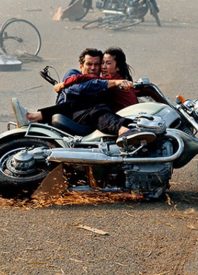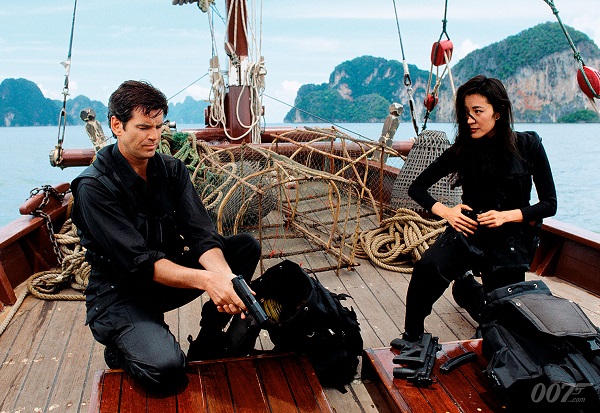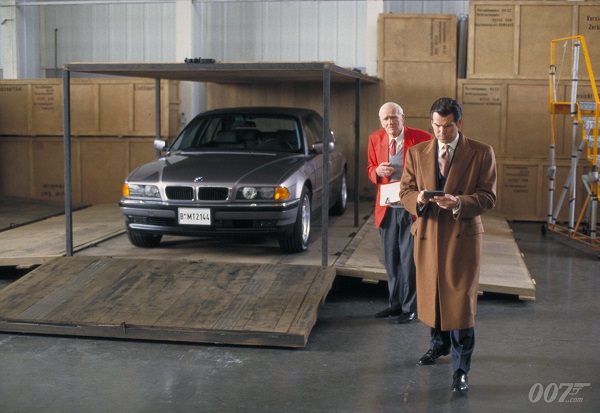
“I never believe what I read in the press anyway.”
Pierce Brosnan makes a second outing as Ian Fleming’s James Bond, 007, in the 1997 film, Tomorrow Never Dies. With a successful entry into the series with GoldenEye, the production on Tomorrow Never Dies feels more confident and self-assured. And an argument could be made that it is a better film than its predecessor.
As much as I enjoy GoldenEye, Brosnan seems more suited to the role in this film. He filled out a little more, and the story has a nice balance between action, gadgets, stunts, and exotic locations. The film features my favourite Brosnan pre-credits sequence and remains a solid entry in the franchise.
In front of the camera Judi Dench returned as M., with Colin Salmon appearing as one of her aides. Samantha Bond and Desmond Llewelyn reprise their roles of Moneypenny and Q. Jonathan Pryce menaces 007 as Carver, a media mogul who has designs on starting a war through his headlines, and profiting off the coverage. Teri Hatcher signed on as Paris Carver, Carver’s wife, and an ex-lover of Bond. Meanwhile Michelle Yeoh stars as Wai Lin a Chinese agent who is more than the equal of Bond. Rounding out the cast is Vincent Schiavelli, Gotz Otto, Joe Don Baker, Ricky Jay, Geoffrey Palmer, Julian Fellowes (the creator of Downton Abbey). And watch for a pair of cameos aboard British ships, one by Gerard Butler, the other by Simon Pegg.
The series original producer Albert ‘Cubby’ Broccoli passed months after the release of GoldenEye, leaving Barbara Broccoli and Micheal G. Wilson as the series producers. Roger Spottiswoode, a Canadian born director, took over the helm behind the camera. Production designer Peter Lamont was busy with Cameron’s Titanic. So, the production brought aboard Allan Cameron who had just worked on Starship Troopers, giving the film a very tech-heavy look. Cutting the film together was Dominique Fortin, and Micheal Arcand. Meanwhile Robert Elswitt served as DOP and Lindy Hemming returned as the film’s costume designer.
I personally felt delight when I learned legendary stuntman Vic Armstrong served as Stunt Coordinator and Second Unit Director. He was originally lined up to direct if Spottiswoode passed on the project. Armstrong has done fantastic work for decades. And he has been involved with some of the biggest action movies of all time.
Bruce Fierstein who had helped craft GoldenEye, pitched a tale of words as weapons. And the producers let him run with it. Spottiswoode did a little re-writing and asked for some help, including some given by Nicholas Meyer. Although Fierstein maintained sole writing credit for the film. The film sees 007 travelling the globe in an attempt to stop Carver, even if that means seducing his wife. He pairs up with Wai Lin as Carver heightens the possibility of war between the UK and China. Carver escalates that tension with his headlines, and his stealth ship (that despite it’s appearance, is based on actual technology).
And speaking of technology, 007 retires his PPK to holster the new Walther P99, while Q outfits him with a fully equipped, remote control BMW, the 750iL. That car gets to shine in a standout sequence that just serves as fun, while demolishing a car park.
The film includes some great aerial photography, featured at the beginning of the film. It also highlighted a High Altitude Low Opening (HALO) jump, a stunt performed by Bond veteran B.J. Worth. The film also features stunts on motorcycles, BMW of course (the R 1200 c). There’s a leap from the Sinn Sathorn Tower in Bangkok (done with stuntmen, the actors, rebuilt sets, replicas, and miniatures).
David Arnold takes over scoring on a recommendation from John Barry. Although both felt upset about not having involvement in the title song. Sheryl Crow performed the song, which consequently doesn’t show up in the score itself. Arnold, however, wrote Surrender for the end credits which was performed by k.d. lang. He incorporated pieces of that music in the film. Arnold proved his love for the series with a cover album, Shaken and Stirred: The David Arnold James Bond Project. And from his opening music cue for the film, White Knight, it’s obvious the franchise’s musical needs are in good hands. Underscoring Crow’s theme song, Daniel Kleinman creates the title sequence carrying on the Maurice Binder/007 tradition in a grand way.
Leavesden Studios and Pinewood Studios was unavailable, Star Wars: The Phantom Menace took over those sets. So, they used a converted warehouse for a number of interiors. And the production shot at various locations around the globe including Germany, the Pyrenees in France, Thailand, Mexico, and of course, the UK.
A release date was set for the UK of 12 December, 1997. The North American opening is a few days later on the 19th. Trailers were crafted, and posters had to be created. Randi Braun oversaw the poster art featuring Keith Hamshere and George Whitear’s photography. It featured Bond, Paris and Wai Lin standing in front of a background of images from the film all encapsulated in media screens. It hints at the film’s theme of media controlling the flow of information. The UK and US posters feature different images and color tones in the screens. But the images are similar enough to be instantly recognizable for what it is, the new James Bond. The Japanese advance poster featuring the trio is unique in its style and presentation. That poster doesn’t even hint at the film’s story or themes, focusing instead on the cast.
Tomorrow Never Dies fills itself with set pieces, stunts, and a top-drawer cast. It also has a great score (David Arnold would deliver some of my favorite James Bond music cues). It was a welcome addition to the James Bond franchise, moving the film solidly towards the next century while still honoring the things that had gotten it this far. Brosnan is charming, Yeoh is fantastic. Pryce is a fairly solid villain believable in his pathology. And he’s all too recognizable in today’s society where headlines rule.
At the box office, the film performed better than GoldenEye. That showed that cinema lovers around the world had embraced Brosnan’s Bond and wanted to see more of him. The film itself remains slick, exciting. Sleek looking, it shows Brosnan at his most comfortable playing 007, and actually gives him a truly worthy ally in Wai Lin. The end credits once again remind us that James Bond Will Return…
Thank you again to my own personal Q Branch DK Canada’s library of James Bond books, specifically The James Bond Encyclopedia. Also thanks to James Bond: 50 Years of Movie Posters, and Bond By Design: The Art of the James Bond Films.
- Release Date: 12/12/1997




